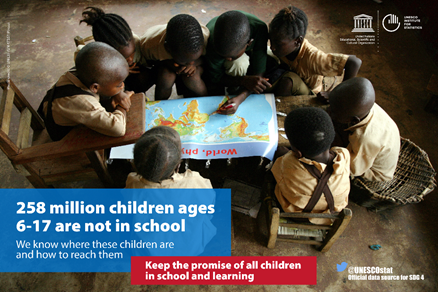A blog by SI UN Representative, Paris, Evelyne Para.
“I attended an event during the 40th UNESCO General Conference in November in Paris which focused on ‘tools to help countries monitor and achieve the global education goal’ (Sustainable Development Goal 4).
At this event, the UNESCO Institute for Statistics (UIS) presented the latest information on key policy issues related to school access, participation and completion by education level, learning outcomes, equity, teachers and education funding from its global database as well as the new edition of its flagship publication, the SDG 4 Data Digest.
What does the new data tell us?
 UIS’s new data confirms that the situation of out-of-school children has stalled without significant improvement for the last ten years. In 2018, more than 258 million children, adolescents and youth, were denied the right to education. If we continue on this path, 1 in 6 children aged 6 to 17 will still not be in school by 2030, and only 6 out of 10 will complete secondary school. What is particularly alarming is that the out-of-school children continue to be the most vulnerable: they tend to be the poorest, those who face entrenched discrimination and, very often, those caught up in conflict.
UIS’s new data confirms that the situation of out-of-school children has stalled without significant improvement for the last ten years. In 2018, more than 258 million children, adolescents and youth, were denied the right to education. If we continue on this path, 1 in 6 children aged 6 to 17 will still not be in school by 2030, and only 6 out of 10 will complete secondary school. What is particularly alarming is that the out-of-school children continue to be the most vulnerable: they tend to be the poorest, those who face entrenched discrimination and, very often, those caught up in conflict.
Girls are the first to be excluded, and they continue to face the greatest barriers. According to UIS data, 9 million girls of primary school age will never set foot in a classroom compared to about 3 million boys.
Collecting reliable data is essential…
 The ambitious nature of the Sustainable Development Goal on education (SDG 4) demands more and better data to guide the policies and resources aimed at providing a quality education for all. Yet today, many countries are struggling to report data on critical issues related to education access and quality, especially in the area of learning outcomes, which lies at the heart of the 2030 Agenda. Some countries face physical barriers to regular collection of reliable data, especially in remote areas or in areas without access to electricity and the Internet.
The ambitious nature of the Sustainable Development Goal on education (SDG 4) demands more and better data to guide the policies and resources aimed at providing a quality education for all. Yet today, many countries are struggling to report data on critical issues related to education access and quality, especially in the area of learning outcomes, which lies at the heart of the 2030 Agenda. Some countries face physical barriers to regular collection of reliable data, especially in remote areas or in areas without access to electricity and the Internet.
In response, the UNESCO Institute for Statistics, in collaboration with the Global Education Monitoring (GEM) Report, presented new data and policymaking tools to Member States, that will help countries produce and use indicators in order to monitor and achieve SDG4.
…to better identify the gaps that need to be addressed
Motivated by the launch of the SDG 4 Data Digest, the discussion brought forward the latest methodological developments for global and thematic indicators for the education goals, shedding light on ways to improve the availability of data and highlighting regional initiatives to monitor progress towards SDG 4.
Ministers of Education, NGO Representatives, and education policymakers joined the Director of the UNESCO Division for Education 2030 Support and Coordination in a candid discussion. They shared their experiences with producing and using education data, maximising peer learning about effective policy solutions to deliver quality, inclusive education for all. Some examples of subjects discussed are: training more qualified teachers in several regions, paying the cost of childrens’ studies, securing accommodation for students, and the use of new technologies to access populations in isolated rural areas.
In conclusion
Education matters. It stands for the hopes and dreams of many children around the world. Education paves the way towards more productive, healthier, sustainable, and resilient societies in which children can reach their full potential. So, we must now move faster to ensure that no child is left behind.
It is not too late to reach the global goal of education. But without reliable, up-to-date, and comparable data on education, and without changing approaches to the supply and quality of education, we may not succeed.”

